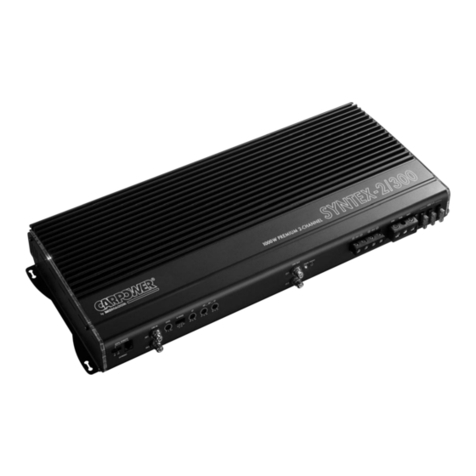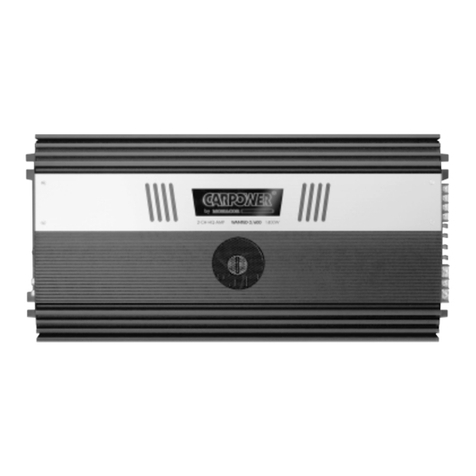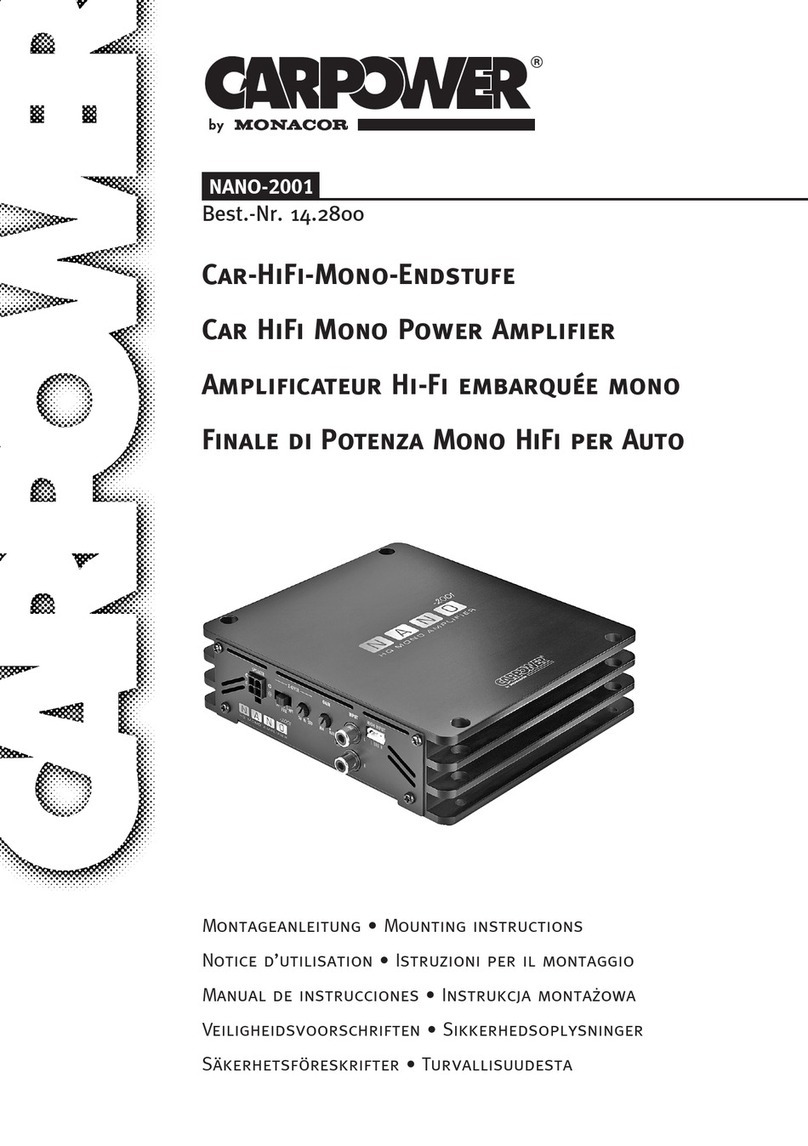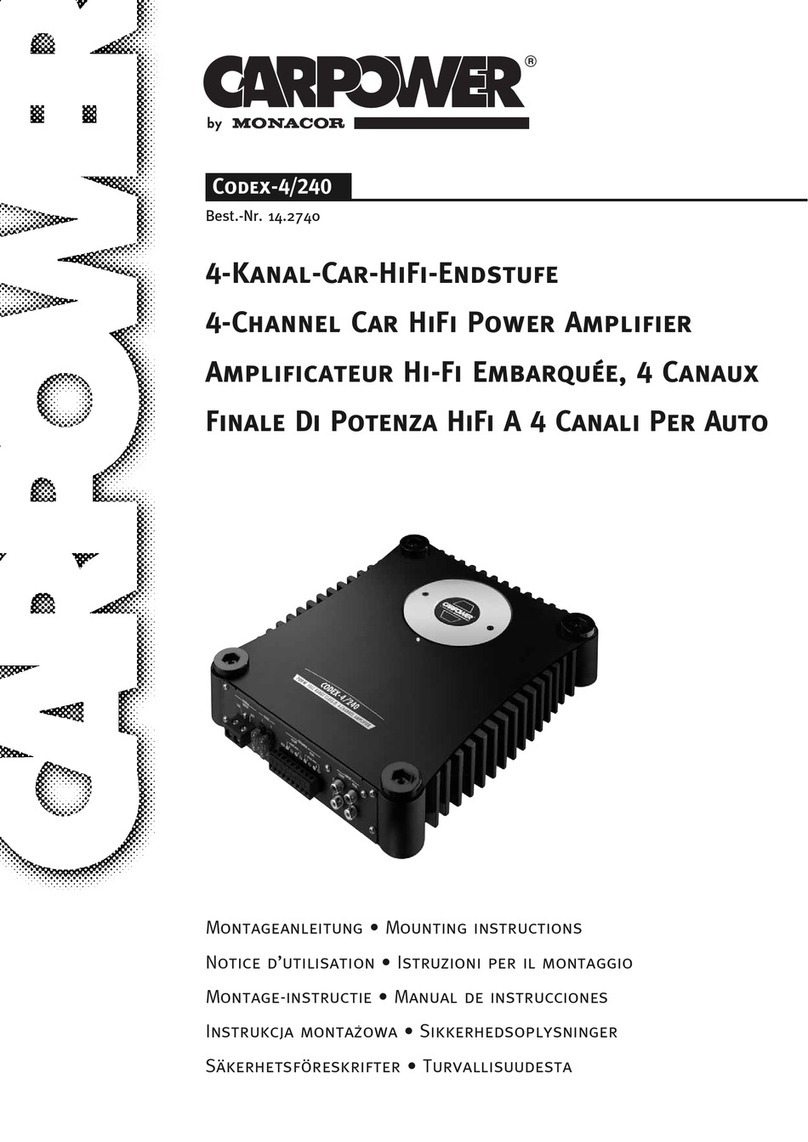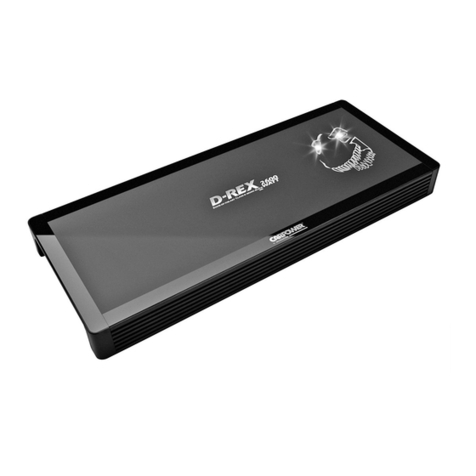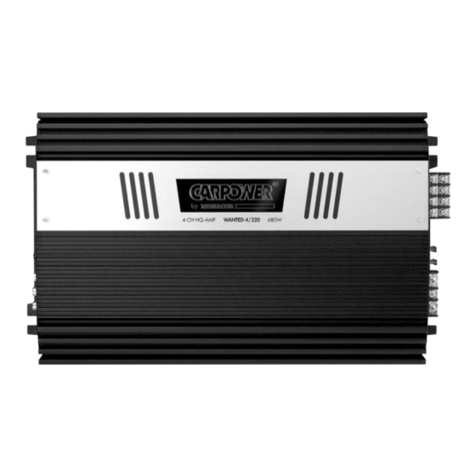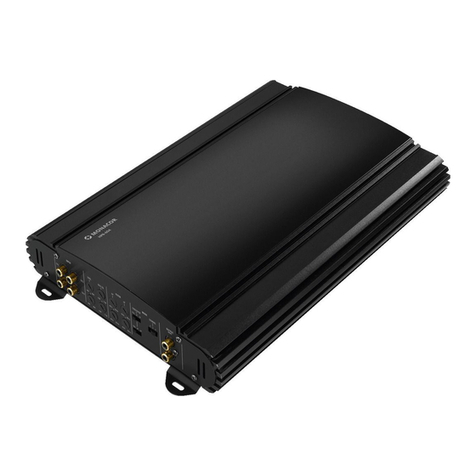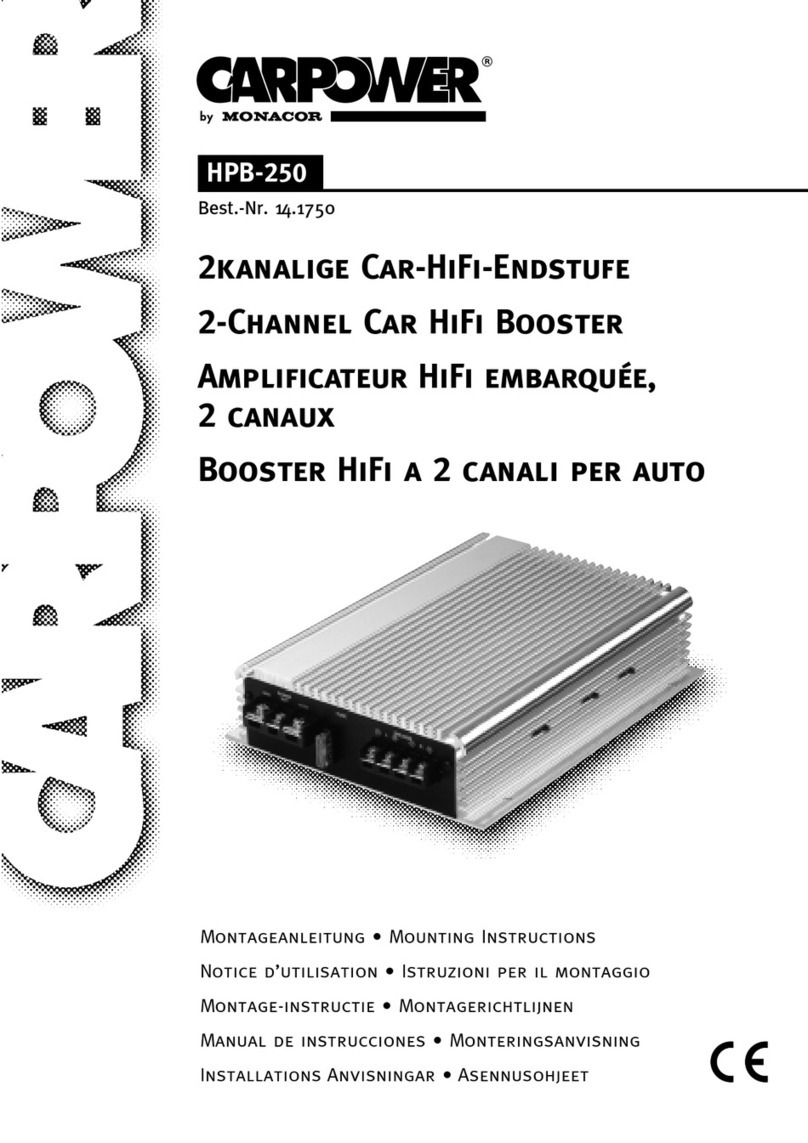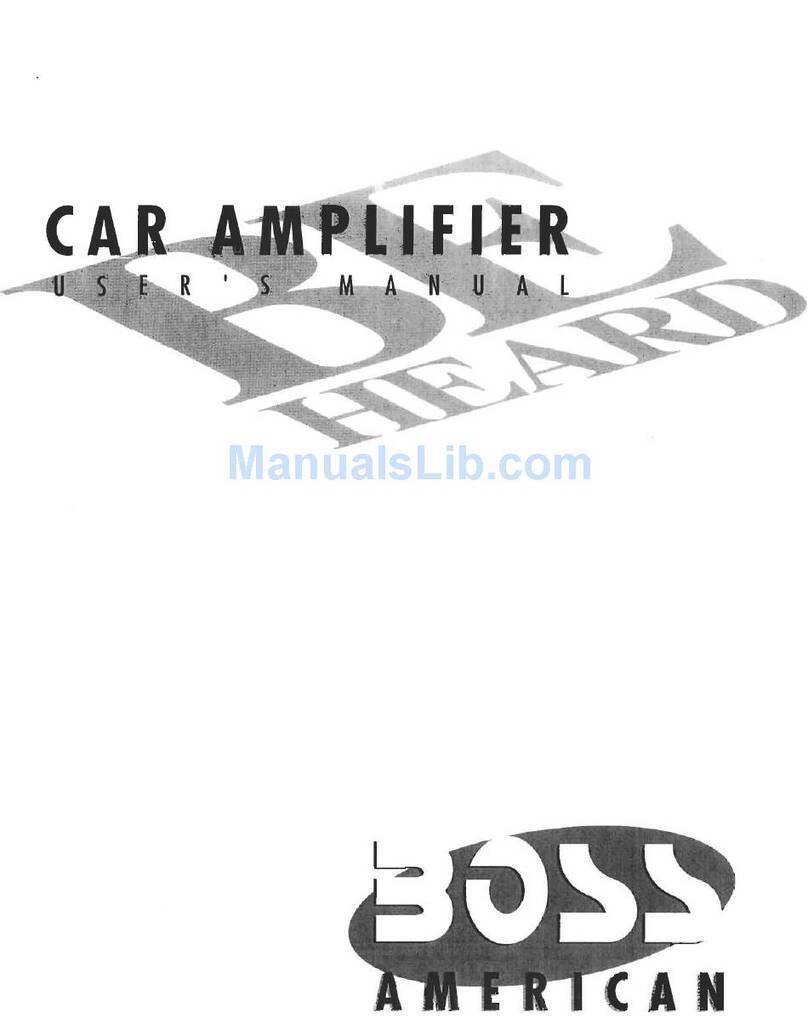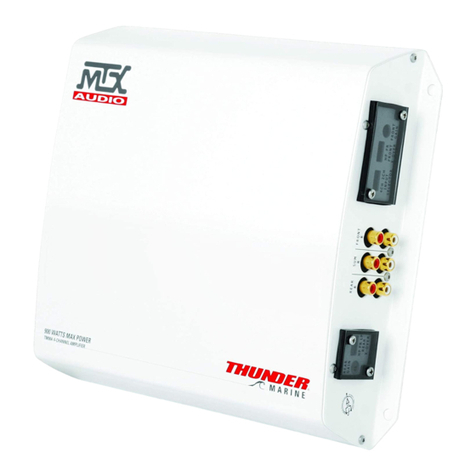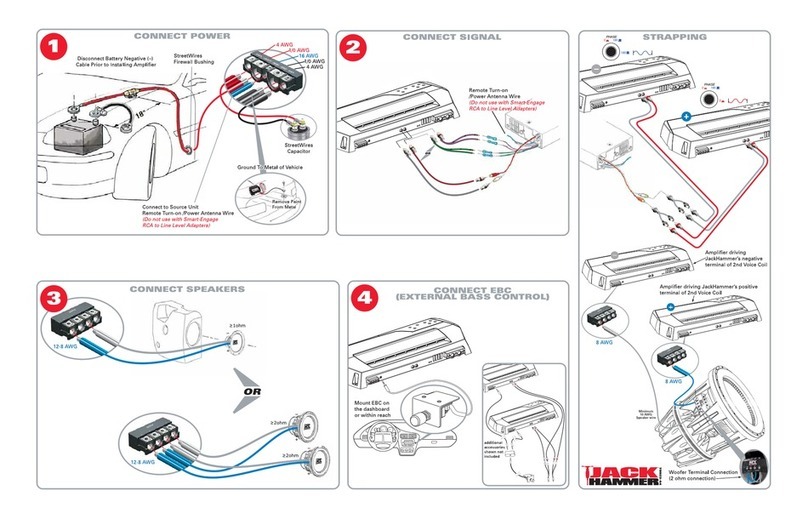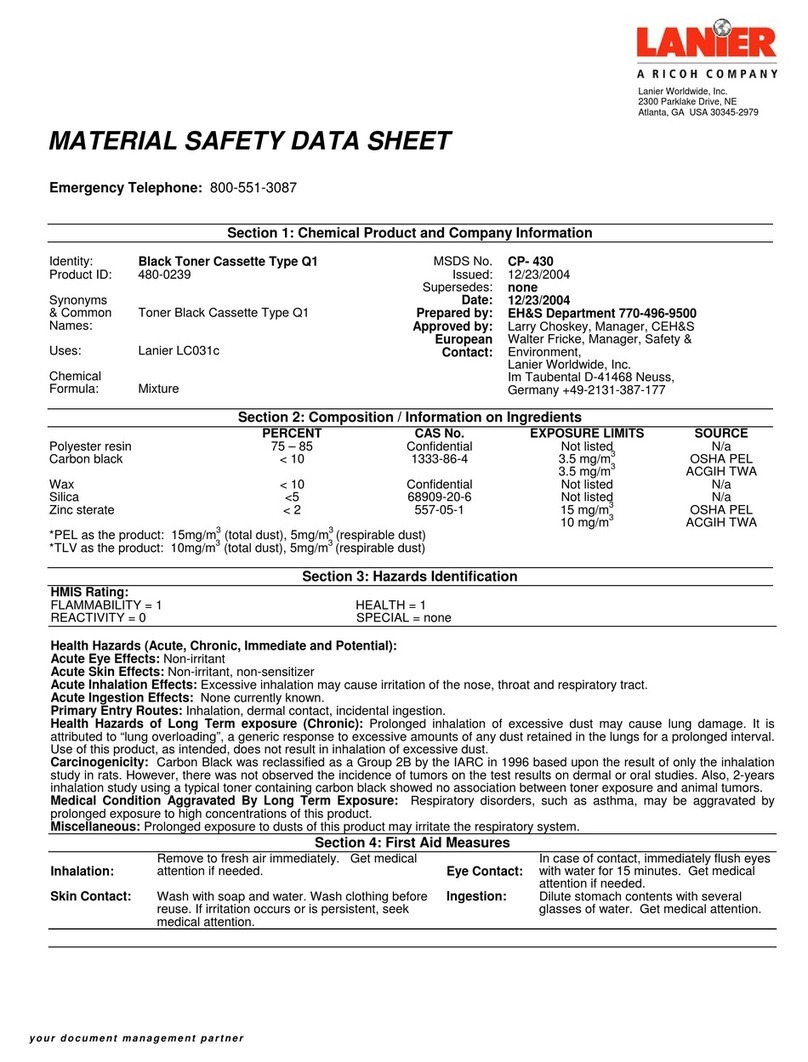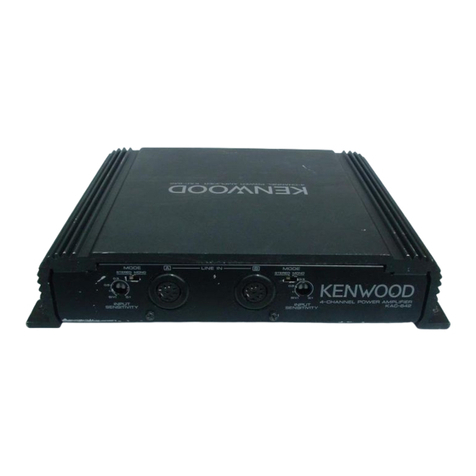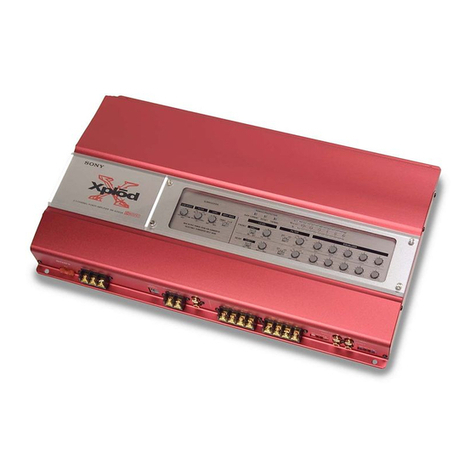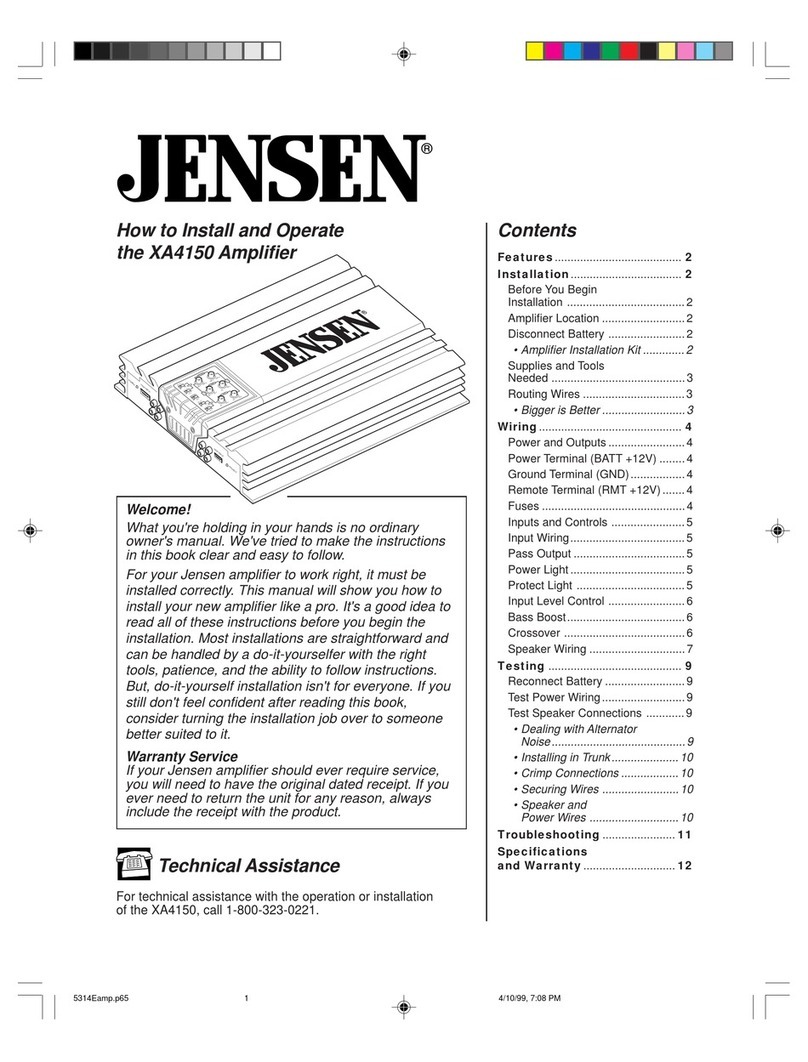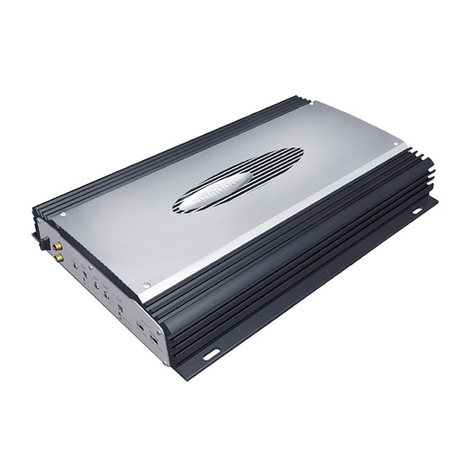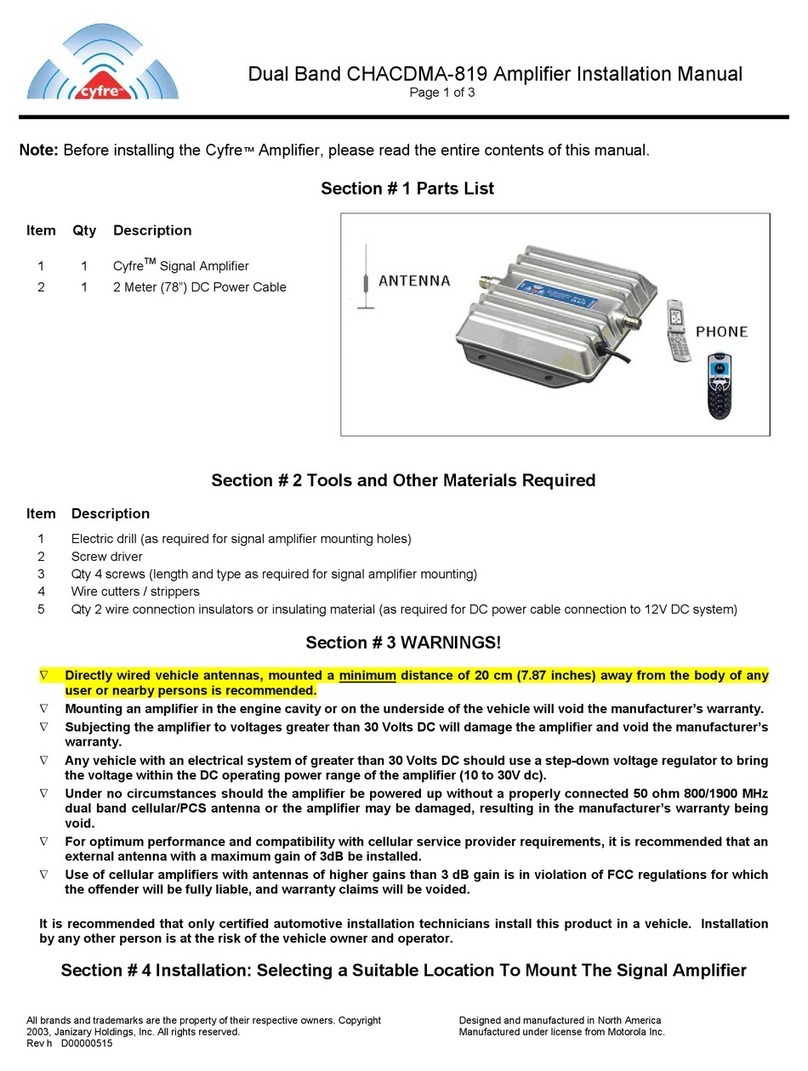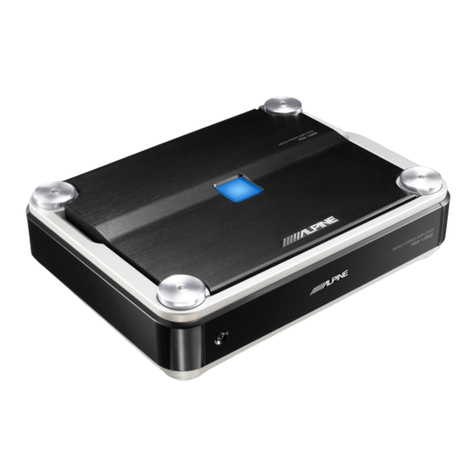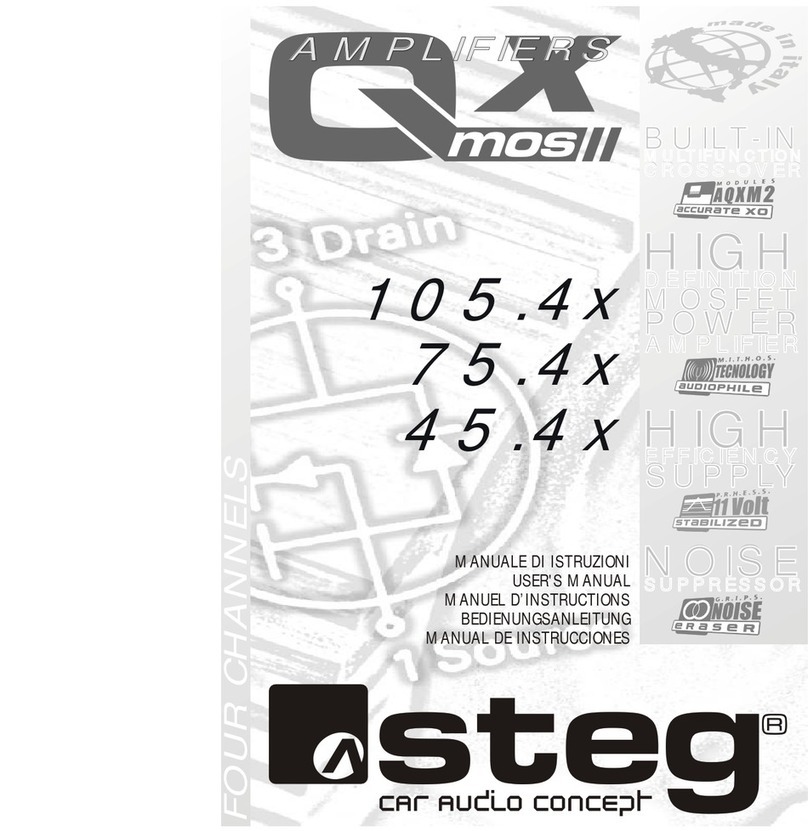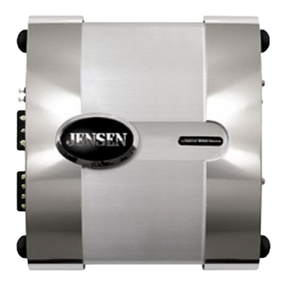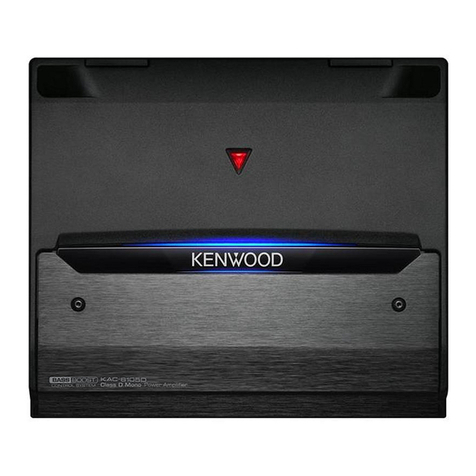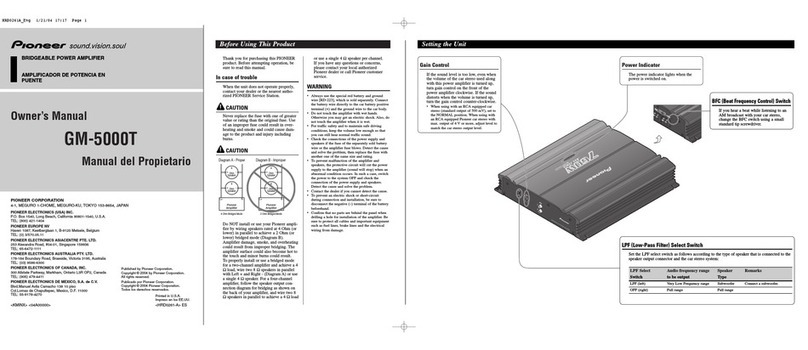3 Vorsicht bei hohen Lautstärken
GBei ausgeschaltetem Motor sollte die Car-HiFi-
Anlage nicht längere Zeit mit hoher Lautstärke
betrieben werden. Die Autobatterie wird schnell
entladen und liefert dann eventuell nicht mehr ge-
nügend Energie zum Starten.
4 Einsatzmöglichkeiten
Die Endstufe POWER-1/1000D ist speziell für den
Betrieb eines hochbelastbaren Subwoofers in einer
Car-HiFi-Anlage konzipiert. Die Ausgangsstufe
arbeitet digital (D-Betrieb), wodurch ein hoher Wir-
kungsgrad bei minimaler Erwärmung erreicht wird.
Die Sinusausgangsleistung beträgt max. 1200 W bei
Verwendung eines 1-Ω-Subwoofers.
Die Endstufe ist mit einem einstellbaren Tief-
passfilter ausgestattet, sodass keine weiteren Filter
für den Betrieb benötigt werden. Zum Schutz des
Subwoofers vor Frequenzen unterhalb des mensch-
lichen Hörbereiches (Infraschall) ist ein einstellbares
Subsonic-Filter integriert.
5 Montage
Bei der Auswahl des Montageplatzes unbedingt die
folgenden Punkte beachten:
GDas 12-V-Stromversorgungskabel von der Batte-
rie zur Car-HiFi-Endstufe sollte so kurz wie mög-
lich sein. Es ist günstiger, längere Lautsprecher-
kabel zu verwenden und dafür ein kürzeres
Stromversorgungskabel.
GDie Masseleitung von der Endstufe zum Fahr-
zeugchassis sollte ebenfalls so kurz wie möglich
sein.
GUm die entstehende Wärme der Car-HiFi-
Endstufe ableiten zu können, muss eine ausrei-
chende Belüftung gewährleistet sein.
GWegen der beim Bremsen auftretenden Kräfte
muss die Endstufe an einer mechanisch stabilen
Stelle fest angeschraubt werden.
GDie Sicherungen und die Regler müssen zugän-
gig sein.
GDie Endstufe sollte elektrisch isoliert vom Fahr-
zeugchassis montiert werden.
Die Endstufe über die vier Befestigungspunkte am
Kühlkörper an geeigneter Stelle festschrauben.
6 Endstufe anschließen
GDer Anschluss der Car-HiFi-Endstufe an das Bord-
netz darf nur durch qualifiziertes Fachpersonal
erfolgen.
GUnbedingt vor dem Anschluss die Minusklemme
der Autobatterie abschrauben, um bei einem
eventuellen Kurzschluss während der Installation
Schäden zu vermeiden.
GDie erforderlichen Kabel so verlegen, dass deren
Isolierung nicht beschädigt werden kann.
Der gesamte Anschluss ist in der Abbildung 3 auf
der Seite 3 dargestellt.
6.1 Stromversorgung
6.1.1 Betriebsspannung
Den Anschluss „+12V“ (14) über ein entsprechendes
Kabel mit der Plusklemme der Autobatterie verbin-
den. Um den Spannungsverlust durch das Kabel
gering zu halten, sollte mindestens ein Querschnitt
von 30 mm2verwendet werden, z. B. CPC-300/RT*.
Um die neu verlegte 12-V-Leitung gegen einen Kurz-
schluss abzusichern, muss eine 150-A-Vorsicherung
in unmittelbarer Nähe der Batterie zwischengesetzt
werden (max. Kabellänge zur Batterie 20 cm).
Zur Stabilisierung der Betriebsspannung für die
Endstufe und der damit verbundenen Leistungsstei-
gerung sowie Klangverbesserung wird ein Power-
Kondensator empfohlen (z. B. CAP-…*).
6.1.2 Masseanschluss
Den Masseanschluss GND (16) über ein Kabel mit
einem Querschnitt von mindestens 30 mm2(z. B.
CPC-300/SW*) mit der Masse des Autos oder bes-
ser direkt mit der Minusklemme der Autobatterie ver-
binden.
Hinweise:
1. Bei Verwendung der Karosserie als Massean-
schluss muss die verwendete Stelle einen guten
elektrischen Kontakt zur Hauptkarosserie aufwei-
sen (z. B. durch ausreichend viele Schweiß-
punkte). Eventueller Lack am Kontaktpunkt muss
vollständig entfernt werden.
2. Zur Vermeidung von Masseschleifen muss die
Masse des Autoradios an die Stelle gelegt wer-
den, an der auch die Endstufe an Masse liegt.
6.1.3 Steuerspannung zum Einschalten
Die Car-HiFi-Endstufe wird durch eine Steuerspan-
nung von +12 V am Anschluss REM (15) ein- und
ausgeschaltet. Den Anschluss REM mit dem 12-V-
Schaltausgang vom Autoradio verbinden (Anschluss
für eine Motorantenne, eventuell mit der Motoran-
tenne parallel schalten).
VORSICHT Stellen Sie die Lautstärke nie sehr
hoch ein. Extrem hohe Lautstärken
können das Gehör schädigen.
Das Ohr gewöhnt sich an hohe Laut-
stärken und empfindet sie nach eini-
ger Zeit als nicht mehr so hoch. Erhö-
hen Sie darum eine einmal einge-
stellte hohe Lautstärke nach der
Gewöhnung nicht weiter.
Während des Autofahrens dürfen Signaltöne, z. B.
von einem Rettungswagen, nicht durch eine zu hohe
Lautstärke der Car-HiFi-Anlage übertönt werden.
Soll das Gerät endgültig aus dem Betrieb
genommen werden, übergeben Sie es zur
umweltgerechten Entsorgung einem örtli-
chen Recyclingbetrieb.
3 Caution in Case of High Volumes
GWith the motor switched off, the car HiFi system
should not be in operation at high volume for a
longer period of time. The car battery will quickly
be discharged, and then it may not be capable any
more of supplying sufficient energy for starting the
car.
4 Applications
The power amplifier POWER-1/1000D has especial-
ly been designed for the operation of a subwoofer of
high power capability in a car HiFi system. Due to
the digital operation (D mode) of the output amplifier,
a high efficiency at minimum heating-up is reached.
The rms output power is 1200 W as a maximum
when using a 1 Ω subwoofer.
The power amplifier is equipped with an adjust-
able low pass filter so that no further filters are re-
quired for the operation. As a protection of the sub-
woofer against frequencies below the human hear-
ing range (infrasound) an adjustable subsonic filter
is integrated.
5 Mounting
When choosing the place of mounting, always
observe the following items in any case:
GThe 12 V power supply cable from the battery to
the car HiFi power amplifier should be as short as
possible. It is better to use longer speaker cables
and a shorter power supply cable instead.
GThe ground cable from the power amplifier to the
chassis of the car should also be as short as pos-
sible.
GFor carrying off the heat being generated by the
car HiFi power amplifier, a sufficient ventilation
has to be ensured.
GAs forces occur during braking, the power ampli-
fier must tightly be screwed to a mechanically
stable place.
GThe fuses and the controls must be accessible.
GThe power amplifier should be mounted electri-
cally insulated from the car chassis.
Tightly screw the amplifier via the four fixing points
at the heat sink at a suitable place.
6 Connection of the Power Amplifier
GThe connection of the car HiFi power amplifier to
the electric system of the car must only be carried
out by qualified, specialized personnel.
GTo prevent damage in case of a possible short cir-
cuit during installation, prior to the connection it is
indispensable to screw off the negative terminal of
the car battery.
GLay the necessary cables so that their insulation
cannot be damaged.
The complete connection is shown in fig. 3 on page 3.
6.1 Power supply
6.1.1 Operating voltage
Connect the terminal “+12V” (14) via a correspond-
ing cable to the positive terminal of the car battery.
To keep the voltage loss by the cable as low as pos-
sible, a minimum cross section of 30 mm2should be
used, e. g. CPC-300/RT*. To protect the newly laid
12 V cable against a short circuit, insert an additional
150 A fuse very close to the battery (max. cable
length to the battery 20 cm).
To stabilize the operating voltage for the power
amplifier and thus the resulting power increase and
sound improvement, a power capacitor is recom-
mended (e. g. CAP-...*).
6.1.2 Ground connection
Connect the ground terminal GND (16) via a cable
with a minimum cross section of 30 mm2(e. g. CPC-
300/SW*) to the ground of the car or better directly
to the negative terminal of the car battery.
Notes:
1. When using the chassis as a ground connection,
the place used must have a good electrical con-
tact to the main chassis (e. g. by a sufficient num-
ber of welding points). Any lacquer at the point of
contact must completely be removed.
2. To prevent ground loops, the ground of the car
radio must be applied at the place where also the
power amplifier is grounded.
6.1.3 Control voltage for switching-on
The car HiFi power amplifier is switched on and off
by a control voltage of +12 V at the terminal REM
(15). Connect the terminal REM to the 12 V control
output of the car radio (connection for a motor
antenna, if necessary, to be connected in parallel to
the motor antenna).
If the unit is to be put out of operation defi-
nitively, take it to a local recycling plant for
a disposal which is not harmful to the envi-
ronment.
CAUTION Never adjust the volume very high.
Extremely high volumes may damage
your hearing.
The human ear gets accustomed to
high volumes which do not seem to
be so high any more after some time.
Therefore, do not further increase a
high volume which has once been
adjusted after getting used to it.
While driving in the car, signal sounds, e. g. by an
ambulance, must not be drowned by the volume of
the car HiFi system which has been adjusted too
high.
5
GB
D
A
CH
* von CARPOWER
* by CARPOWER
